This was the day I would pass most of the locks and sections of the canal visible from
the New York Throughway, so it was a section I was very eger to see.
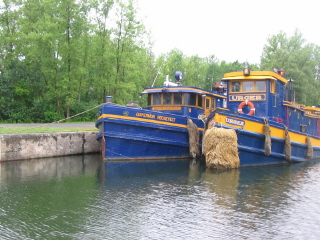 |
There are several canal maintenance areas along the canal, and quite a number
of tug boats. I'm a nut for tug boats, so always take photos of them. Someday
I will have to own a tug, or at least a nice model of one.
There are also several self propelled barges, some with backhoes mounted on them, and a
variety of construction equipment. Apparently the Canal Authority does most of its
owm maintenance work. |
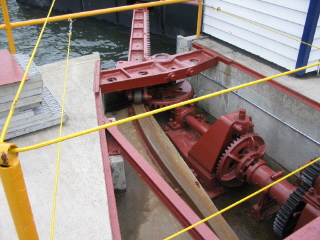 |
This is the gear drive to open a lock gate. All the locks seemed to have the
cover plates off these gearboxes, and the water gate mechanism.
These locks are all very gentle in motion, unlike some of the Rideau locks. These use
a large gate valve at each end of a water tunnel. Water is admitted to the lock chamber through
a series of 10 ports along each side. The valves were described as 'like a railroad
flatcar, with wheels rolling on a vertical track.' They are lifted by a steel
cable wrapped around a drum and drivenby electric motors. At the gatehouse of each
lock there is a set of 3 light bulbs mounted verticall that show the position of the
gate valve, all lights off and its closed. They open it in three stages to keep
the water moving fast, but calm in the lock.
|
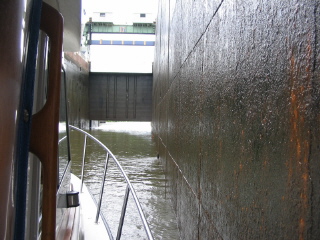 |
Lock 17 at Little Falls is the biggest drop- 41 feet. It has a vertical lift gate
at the low end. Of course it drips water all over the boat as you leave the lock.
|
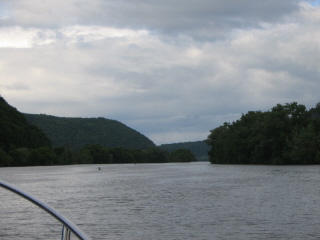 |
This is one of the natural passes the Mohawk River makes through the ridge
of the Applichain Mountains. The NY Throughway and the Railroad all share this
pass with the Mohawk River. |
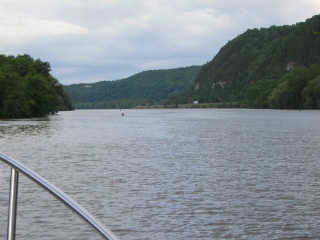 |
Another shot, a littel further into the pass. |
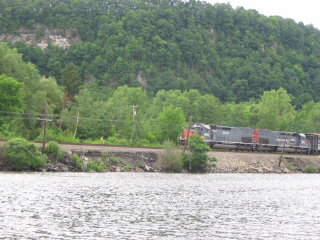 |
The railroad is on the North side of the pass, and it is a very busy line.
There were long freights as often as every 10-15 minutes all the time I was along this
section.
|
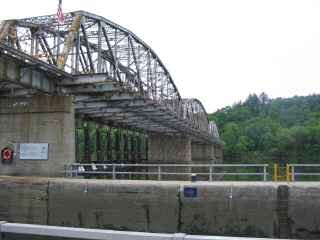 |
These photos are of the lock at Amsterdam, but are very typical of all the locks
in the lower section of the Mohawk. These were built in the early 1900s. The original canal
was all dug, because they could not build damns that would withstand winter ice and
spring runoff in the ealry 1800's.
The Mohawk is now a series of ponds behind each dam, kind of long narrow lakes.
|
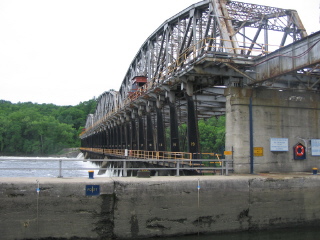 |
To solve the ice problmes the dams were built as moveable dams- a bridge over
the river supports a series of gates that can be lowered into the river as a dam. In the
winter these are lifted up to the bridge by the large chains. That not only protects
the dam, it lowers the river back to its original bed and leaves the locks dry for maintenance.
When I was here there had been 3 days of rains, apparently heavy to the North. The river
was high, and the lock tenders were busy adjusting the dams to draw the level down.
There is always a current on the lower level of the lock, as it merges with the flow from
the dam, but with the high water it was wild at a couple locks. I went out of the gates with the
throttle well forward to maintain steering. |
I ran until 8:00 PM, then stopped at Amsterdam. It was a nice wall, and a nice park, but it was only
about 300 feet wide- the backedge was that railroad line I've been following all day. There
were trains all night long, all giving a long whistle as they approached the town. I thought
the railroads were dead in the US, but this line is sure active- moslty hauling double decked
containers, probably from the port of New York.